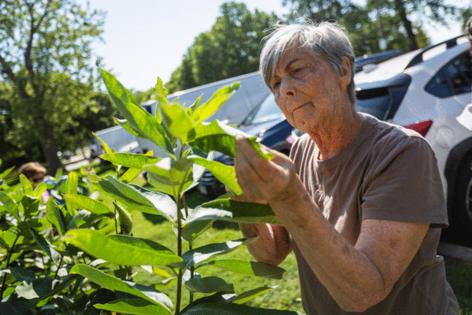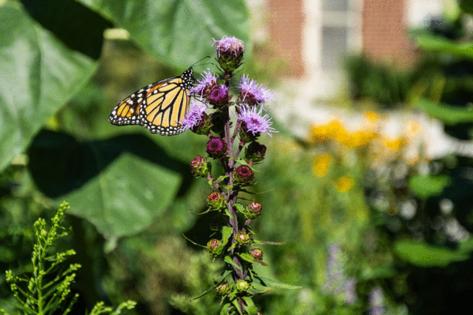

CHICAGO — An expert has confirmed what backyard gardeners and amateur naturalists have been saying for weeks: There are fewer monarch butterflies in Illinois this summer.
At the national Monarch Larva Monitoring Project, which tracks the number of eggs the butterflies are laying, the counts are down, both in the Prairie State and the larger region, according to the project’s founder and coordinator Karen Oberhauser.
“The numbers are low throughout the Upper Midwest,” she said.
Monarch butterflies, known for a jaw-dropping fall migration of up to 3,000 miles, have been in decline since the 1990s, due to factors such as loss of milkweed habitat.
The U.S. government has determined that the showy orange and black butterflies qualify for threatened or endangered species status, but has effectively waitlisted them.
Monarch Watch Director Kristen Baum said that reports of low summer monarch numbers in the Upper Midwest are “definitely concerning.”
“Lots of people are reporting they haven’t seen monarchs where they normally do, or they’re seeing their first monarch really late, so there are definitely reports of less activity,” she said.
Still, she said, measuring the monarch population is challenging, with a range of different data sources to weigh, and a lot remains to be seen, including results from Monarch Watch’s monarch-tagging program in late summer and fall.
Among the possible reasons for low numbers in the Upper Midwest this summer: The “super generation” of butterflies that migrate to Mexico had a very bad winter in 2023-2024, the second worst on record.
The estimated winter population numbered just 19 million, down 59% from the previous year.
That left fewer surviving butterflies to fly north in spring, lay their eggs in southern states, and set the stage for a multigenerational northern migration.
The low winter numbers could help explain initial egg counts in the Upper Midwest. But the egg-laying generally increases during the summer, reaching a second, higher peak as the monarch population builds, Oberhauser said. And that’s not what happened this year.
In fact, throughout the Upper Midwest, the second peak was lower than the first.
In Illinois, the egg count fell from about 15 eggs, caterpillars or pupas per 100 milkweeds during the highest count in May, to just 10 per 100 during the highest count in July.
That compares with a high of roughly 30 eggs, caterpillars or pupas per 100 milkweeds in May 2023, and roughly 45 per 100 in July of that year.
“The story is, we’re puzzled at this point,” as to why the 2024 numbers are low, said Oberhauser, a professor emerita of entomology at the University of Wisconsin at Madison. “And before we have all the data and can really look at weather patterns over a broad scale, we’re only guessing.”
Still, she said, she has a theory, based on the large amount of rain toward the end of June. Caterpillars can crawl under leaves for shelter during a heavy rain, and as far as scientists know, eggs don’t wash away.
But adult butterflies, when they first emerge from the hard protective covering called a chrysalis, are quite vulnerable.
“The wings aren’t expanded yet and they kind of have to hold on with their feet. It’s possible that if it’s raining really hard, they get knocked to the ground,” Oberhauser said.
Monarchs are resilient, Oberhauser said. They had a very bad winter in 2013 and 2014, their worst on record, but then rebounded. The population actually more than tripled between the next winter (2014-2015) and the one after that.
Still, the risk is that monarchs could have a couple of bad years in a row, she said.
“If the population is very low and something happens to them, like we have a storm in Mexico or it’s a really dry fall when they’re migrating through Texas and they can’t find enough nectar to feed on, the risk is, (the population) just gets so low that they can’t recover,” she said.
Humans can help. Monarchs can lay more eggs when milkweed is easier to find, Oberhauser said.
She cited a recent Field Museum study she co-authored that showed monarchs lay eggs on small patches of milkweed and nectar plants in Chicago and its suburbs.
“They need flowers and they need milkweed, and the more we provide the easier it’s going to be for them to recover,” Oberhauser said.

©2024 Chicago Tribune. Visit at chicagotribune.com. Distributed by Tribune Content Agency, LLC.



